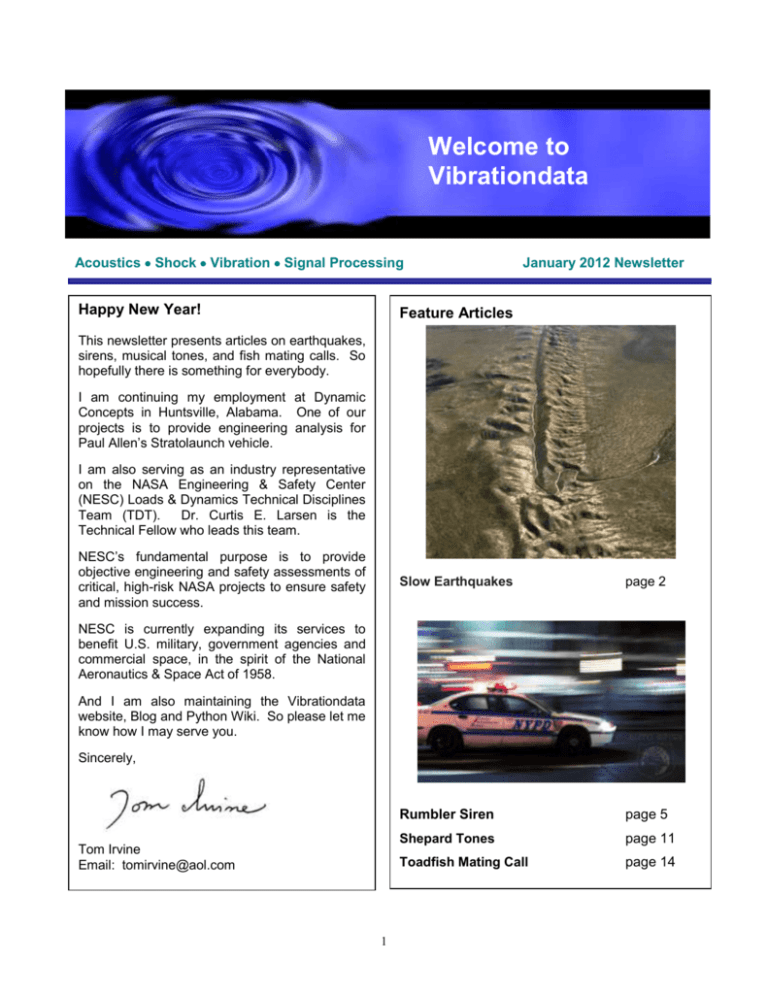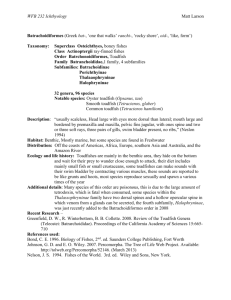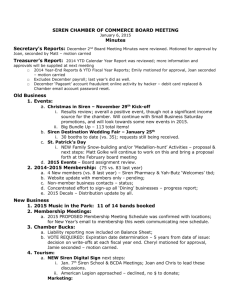January2012_NL
advertisement

Welcome to Vibrationdata Acoustics Shock Vibration Signal Processing Happy New Year! January 2012 Newsletter Feature Articles This newsletter presents articles on earthquakes, sirens, musical tones, and fish mating calls. So hopefully there is something for everybody. I am continuing my employment at Dynamic Concepts in Huntsville, Alabama. One of our projects is to provide engineering analysis for Paul Allen’s Stratolaunch vehicle. I am also serving as an industry representative on the NASA Engineering & Safety Center (NESC) Loads & Dynamics Technical Disciplines Team (TDT). Dr. Curtis E. Larsen is the Technical Fellow who leads this team. NESC’s fundamental purpose is to provide objective engineering and safety assessments of critical, high-risk NASA projects to ensure safety and mission success. Slow Earthquakes page 2 Rumbler Siren page 5 Shepard Tones page 11 Toadfish Mating Call page 14 NESC is currently expanding its services to benefit U.S. military, government agencies and commercial space, in the spirit of the National Aeronautics & Space Act of 1958. And I am also maintaining the Vibrationdata website, Blog and Python Wiki. So please let me know how I may serve you. Sincerely, Tom Irvine Email: tomirvine@aol.com 1 Slow Earthquakes by Tom Irvine Figure 1. Tectonic Plate Boundary near Puget Sound, Washington State Crustal Deformation Mechanisms The earth’s crust can be deformed by earthquakes and creep. High-intensity earthquakes occur primarily along tectonic plate boundaries which undergo stick-slip friction as the plates move relative to one another. The accumulated strain energy may cause a sudden rupture or brittle fracture, generating seismic waves over a period of seconds or minutes. Creep is a very gradual, ductile, viscous deformation, where the crustal material flows almost like a fluid. This process is aided by underlying thermal energy which makes make the tectonic plates pliable and slippery, particularly at increasing depths. A slow earthquake is an intermediate mechanism, which combines some characteristics of both creep and highintensity earthquakes. Slow earthquake temblors may last days, weeks, or even months. They are also referred to as episodic tremor and slip (ETS). Depth Slow earthquakes according to depth. may be categorized Deep slow quakes tend to rupture between 22 to 34 miles (35 to 55 km) below the surface of 2 the Earth, far deeper than their faster counterparts. Shallow slow quakes may rupture at depths of about 3 miles (5 km). There is also a mid-level classification. Rupture Propagation Rate Regular earthquakes streak along a fault at about 1.8 miles/sec (3 km/sec), roughly 10 times the speed of sound in air. Slow quakes tend to migrate at about 4.3 miles/hr (7 km/hr), or about the pace of a brisk walk, and can travel nearly 100 miles (160 km) from start to finish. Measurement The velocities of waveforms generated by slow earthquakes are nearly too low to be measured by traditional seismometers. But some sources have reported that they can be detected by filtering the seismic data in the 1 to 5 Hz band. Other researchers use GPS arrays to detect crustal surface displacement. The GPS data is effective for horizontal displacement measurement, but is less accurate in the vertical axis. Locations Slow earthquakes have been identified as occurring along the Bungo Suido channel in Japan, the San Andreas Fault and other locations throughout the world. But more particular research has been performed for slow quakes occurring in the Pacific Northwest Cascadia region. Puget Sound Slow earthquakes have been identified for the Cascadia subduction zone, as shown in Figure 1. Slow-slip events tend to start in the southern Puget Sound region and move gradually to the northwest, following the interface between the North American and Juan de Fuca tectonic plates. The events typically last three to four weeks and release as much energy as a magnitude 6.8 earthquake, though they are not felt and cause no damage since they happen so slowly. Scientists have also found a distinct signal for tremor clusters moving rapidly backwards from the leading edge of the tremor, through an area of the fault that had already experienced tremors. The scientists have also noted that rapid tremor reversal appears to happen more readily near the Strait of Juan de Fuca, suggesting that stress from tides could play a role in generating the reversal because the interface appears to be more sensitive just after having been ruptured by the initial tremor event. Frequency of Occurrence The more common, high-intensity quakes occur at unpredictable intervals, which is part of what makes them so dangerous. But geophysicist Heidi Houston has noted that the slow quakes in Washington State appear to follow the beat of an unseen geological drum, occurring roughly every 12 to 15 months. 3 Figure 2. GPS Data for Ground Displacement at Three Pacific Northwest Location The pattern is roughly a series of terminal sawtooth pulses. Each ramp result from a slow quake, or series of slow quakes, lasting up to 15 months, followed by a rapid reversal. The graph is taken from: Walter Szeliga, Timothy I. Melbourne, M. Meghan Miller, and V. Marcelo Santillan; Southern Cascadia Episodic Slow Earthquakes, GEOPHYSICAL RESEARCH LETTERS, VOL. 31, L16602, doi:10.1029/2004GL020824, 2004. 4 Rumbler Sirens by Tom Irvine Rumbler Device In response, the Federal Signal Corp. has designed a device called “The Rumbler.” These devices have been installed on police vehicles in New York City and in a few dozen other municipalities. The Rumbler is not a sound source by itself. Rather it is a woofer/amplifer system which transposes the existing electronic siren signals to lower frequencies. Figure 1. Officer Pointing to Rumbler Woofers Emergency Sirens Emergency personnel face numerous challenges in projecting warning sounds to motorists and pedestrians. Four particular concerns are: 1. There is a cacophony of competing sounds in dense urban areas. 2. Many drivers cocoon themselves in their vehicles listening to radios, iPods, and cell phones. 3. The siren sounds may fail to alert drivers who are elderly or hearing impaired. 4. Newer luxury vehicles are designed to provide a quiet interior. There are numerous potential consequences for unheard sirens. Unaware drivers may fail to yield to the emergency vehicle, thus costing the responder precious time in the case of a fire or medical emergency. Furthermore, an emergency vehicle passing through an intersection may be “T-boned” by another vehicle driven by a distracted driver. The resulting low-frequency tones are better able to penetrate vehicle surfaces than the unmodified high-pitched siren tones. Furthermore, the low-frequency sound energy produces jarring vibration which can be felt by both drivers and pedestrians. The Rumbler is intended to be used in a manner whereby the emergency vehicle driver would alternate between the normal siren sounding and the Rumbler’s transposed output. Signal Analysis Emergency vehicles may be equipped to broadcast a number of siren signals per the driver’s discretion. These sounds include air horn, European twotone, wail, welp, and fast. The following graphs show spectral magnitude plots of each of these signals as taken from sound files courtesy of the New York Times. Furthermore, the wail, welp and fast siren signal are also given as transposed by the Rumbler for comparison. Note that the sound pressure amplitude is unscaled. Each of the sound files is given in mp3 format at: http://www.vibrationdata.com/newsletters.htm 5 AIR HORN PRESSURE MAGNITUDE SPECTRUM 5000 AMPLITUDE 4000 3000 2000 1000 0 0 500 1000 1500 2000 2500 3000 3500 4000 4500 5000 FREQUENCY (Hz) Figure 2. The spectral peaks are spaced 64 Hz apart. The highest peak occurs at 1089 Hz. EUROPEAN SIREN MODE PRESSURE MAGNITUDE SPECTRUM 5000 AMPLITUDE 4000 3000 2000 1000 0 0 500 1000 1500 2000 2500 3000 3500 4000 4500 5000 FREQUENCY (Hz) Figure 3. There are two sets of peaks, beginning at 806 and1006 Hz, respectively. Each set has integer multiples thereof. Note that the sets are sounded separately, producing a two-tone effect. 6 Wail Siren Waterfall FFT Figure 5. The fundamental tone sweeps from 700 to 1600 Hz and then down again. also appear at lower amplitudes. Integer harmonics 7 Waterfall FFT Wail Rumbler Figure 6. The Wail signal is passed through the Rumbler. The 700 to 1600 Hz sweep is again present. In addition, a 270 to 400 Hz sweep occurs. 8 YELP SIREN MODE PRESSURE MAGNITUDE SPECTRUM 2000 AMPLITUDE 1500 1000 500 0 0 500 1000 1500 2000 2500 3000 FREQUENCY (Hz) Figure 7. The Yelp signal has a rate of 3.3 pulses per second. Thus, the spectral magnitude is composed of peaks spaced 3.3 Hz apart. The highest individual peak occurs at 1301 Hz. YELP RUMBLER MODE PRESSURE MAGNITUDE SPECTRUM 4000 AMPLITUDE 3000 2000 1000 0 0 500 1000 1500 2000 2500 3000 FREQUENCY (Hz) Figure 8. The Yelp signal is passed through the Rumbler. The 3.3 pulse rate is maintained. The highest peak occurs at 207 Hz. Thus, the sound energy is transposed to lower frequencies via the Rumbler. 9 FAST SIREN MODE PRESSURE MAGNITUDE SPECTRUM AMPLITUDE 3000 2000 1000 0 0 500 1000 1500 2000 2500 3000 FREQUENCY (Hz) Figure 9. The Fast signal has a rate of 12 pulses per second, with a corresponding peak separation in Hz. The highest individual peak is at 1622 Hz. FAST RUMBLER MODE PRESSURE MAGNITUDE SPECTRUM 5000 AMPLITUDE 4000 3000 2000 1000 0 0 500 1000 1500 2000 2500 3000 FREQUENCY (Hz) Figure 10. The Fast signal is passed through the Rumbler. The 12 pulse per second rate is maintained. The highest peak occurs at 210 Hz. Again, the sound energy is transposed to lower frequencies. 10 Shepard Tones by Tom Irvine Figure 1. Ascending and Descending by Dutch artist M. C. Escher Introduction A Shepard tone, named after Roger Shepard, is a series of sweeping sine tones, with frequencies spaced at one octave intervals. The pitch set may either ascend or descend with time. The rate of change may either be continuous or may occur in steps in the case of musical notes. The overall frequency band is limited, such that a tone will resume at the lower limit frequency after it has reached the upper frequency limit, for the case of an ascending series. The resulting series of tone creates an auditory illusion which has been compared to a rotating barber pole or to the Escher print shown in Figure 1. The illusion occurs because the tones continuously sweep either upward or downward while remaining within a limited frequency band. 11 Waterfall FFT Shepard Tone Figure 2. Example An example of Shepard scale is shown in the Waterfall FFT plot in Figure 2 and in the Spectrogram in Figure 3. There are four tones which begin at 27.5, 55, 110, and 220 Hz. Each pitch increases with time until it reaches a maximum frequency of 440 Hz, at which point it resumes at 27.5 Hz. The corresponding shepard_tone.mp3. It was generated shepard_tone.m. audio by file Matlab is: script: Both the script and audio file are included at: http://www.vibrationdata.com/newsletters.htm Furthermore, the amplitude is modulated by a Hanning window to embellish the audio effect. Note that the audio signal was reversed so that the tones descend. (This is a somewhat innovative use of the Hanning window which is normally used to suppress a potential leakage error in the Fourier transform calculation.) 12 Spectrogram Shepard Tone Figure 3. Musical Applications Two examples are: J. S. Bach’s Neverending Canon is based on what is now known as a Shepard scale. http://www.youtube.com/watch?v=vkccY6uU7hY This piece is formally known as Canon a 2 per Tonus, from Bach's "Musical Offering." http://www.frequency.com/video/bachsneverending-canon/6210437 Readers are encouraged to listen to recordings of the piece as available on the Internet. 13 Toadfish Mating Call by Tom Irvine Figure 1. Typical Toadfish Introduction Body There are dozens of Toadfish specifies throughout the world. Toadfish have a scale-less skin covered by thick a mucous layer. Their habitat is shallow marine shoals and estuaries. They are sometimes seen buried in sand with only the eyes exposed. They have a gas bladder for buoyancy. The bladder also serves as a resonating sound chamber in males. The bladder wall acts like the skin over a drum. Sound is produced by the vibration of the walls. Diet Toadfishes feed on small fishes, worms, and crustaceans. The strong teeth and jaws of the toadfish are capable of crushing the hard shells of mollusks and oysters. Mating The mating season begins in April and ends in October. The male emits a foghorn sound to attract females. The female Toadfish will deposit her eggs in a nest and immediately leave them. The male will then fertilize the eggs and protect them from harm. 14 Noise The mating calls propagate efficiently through the water and into the above airspace. This creates a night-time nuisance for people living near the shore, especially those in houseboats, who suffer sleepless nights as a result. Sausalito Hum There is a story that the Toadfish were particularly prolific during 1985 mating season near the shore of Sausalito, a San Francisco Bay community. The mating calls were apparently much louder than in previous years. Yet the source was a mystery. Some thought it was machinery, a secret military experiment, or even a Russian submarine which had clandestinely penetrated the Bay. According to the San Francisco Chronicle, a scientific investigation was begun by an acoustics consulting company. Hydrophonic recordings were taken and spectrum analysis eliminated machinery as the source of the humming. Finally, in August 1985, fish biologists concluded the sound was coming from lovelorn Toadfish males. Figure 2. Three-spined Toadfish Courtesy Aaron Rice Sample Toadfish Sound File A sound file is given in: ToadfishHoot.mp3. The two swim bladders are clearly visible in the abdominal cavity of the fish. The eggs are comparatively large from the beginning and will hatch after roughly one month. The male Oyster toadfish continues to watch over his offspring even after they have become free. This level of care is unusual for fish. The file is posted at: http://www.vibrationdata.com/newsletters.htm It is courtesy of Cornell University, which has a bioacoustic research program. A spectral analysis of the mating call is given in Figure 3. 15 SAMPLE TOADFISH MATING CALL SOUND PRESSURE SPECTRUM 4000 UNSCALED PRESSURE 3000 2000 1000 0 0 100 200 300 400 500 600 700 800 FREQUENCY (Hz) Figure 3. The fundamental frequency is at 155 Hz with integer multiples thereof. This is a D# musical note. 16











